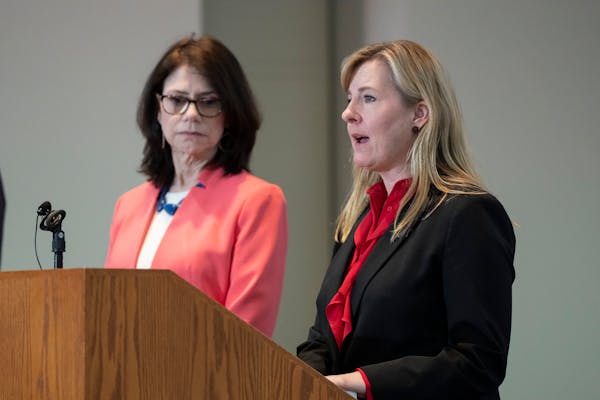Minnesota lawmakers are expected to have a $2.4 billion budget surplus for the upcoming legislative session, but spending it could result in a deficit of nearly the same size in the coming years, according to state estimates released Wednesday.
Though they say the current two-year budget is stable, state officials urged caution and said higher-than-anticipated spending for health and human services and education could result in a shortfall in the 2026-2027 fiscal biennium.
The projected deficit for the next two-year budget cycle is close to the current surplus — $2.3 billion, according to state officials. That projection may change depending on actions in the Legislature and national and global events.
"Policymakers will need to be very thoughtful when making budget decisions this next year," Minnesota Management and Budget Commissioner Erin Campbell said, adding that saving the surplus instead of spending it could offset the future deficit.
The projected $2.4 billion surplus is higher than previously expected — an earlier forecast put the number at $1.6 billion. But it's much smaller than the $17.5 billion surplus the DFL-controlled Legislature used to enact a sweeping list of progressive policies earlier this year. Minnesota's current two-year budget is the largest in state history at $72 billion, and some of that was one-time money.
"We do need to be measured. We need to be careful about where we spend money," DFL Gov. Tim Walz said.
Minnesota also has about $2.85 billion in its rainy day fund.
Republican legislative leaders criticized Walz and the Democrats over the latest budget forecast, saying they "squandered" the larger surplus earlier this year and have driven the state toward a deficit. Legislators have little room for new spending this year, they said.
"Clearly, the [DFL] trifecta has taken a route that has broken the state's budget," said Senate Minority Leader Mark Johnson, R-East Grand Forks.
Assistant House Minority Leader Kristin Robbins, R-Maple Grove, said, "The bottom line is spending is expected to exceed revenues. That's a deficit, my friends."
Walz, House Speaker Melissa Hortman, DFL-Brooklyn Park, and Senate Majority Leader Kari Dziedzic, DFL-Minneapolis, defended their work in the recent legislative session as making long-term investments in children and families that will yield benefits eventually with increased workforce participation and reductions in child poverty.
"We enacted a budget that will improve the lives of Minnesotans for generations," Dziedzic said. "As that budget is implemented, Minnesotans will see the surplus returned to them in many ways."
Democrats funded road and bridge repairs, a program to provide free school meals to all children and local government aid that will help keep property taxes down, among other things, Dziedzic noted.
Hortman touted decreased child-care costs for families, saying Democrats are "growing the economy by growing the middle class."
The latest budget projections all but eliminated talk of tax cuts, even by Republicans, though Robbins still said, "Minnesota families are overtaxed and we need to put an end to this."
Walz was asked whether there could be more tax increases, but he said such discussions are premature.
If the Legislature doesn't use this $2.4 billion surplus, it will roll into the next fiscal biennium and offset the future projected shortfall, turning it into a small $82 million surplus, budget officials said.
Driving spending increases are an influx of non-English speaking students to state schools, higher-than-expected participation and costs for the free school meals program, and spiking costs of home care for seniors and the severely disabled.
The governor signaled that those programs are untouchable. "I'm not cutting meals for kids or services to our most vulnerable," Walz said, adding that he's also not cutting taxes for millionaires or billionaires.
The 2024 legislative session, which starts in February, is a non-budget year that typically revolves around passing a public works borrowing bill to fund state construction projects.
In light of the latest economic forecast, Campbell put the acceptable number for such a bonding bill at $830 million. Dziedzic agreed with that figure. Hortman said that number could easily surpass $1 billion if some of the projects are paid for with existing cash.
Former DFL Senate Majority Leader Kari Dziedzic dies of cancer at age 62

How the Star Tribune is covering the 2024 election

Fact check: Walz and Vance made questionable claims during only VP debate

In Tim Walz's home city, opposing groups watch him debate on the national stage



